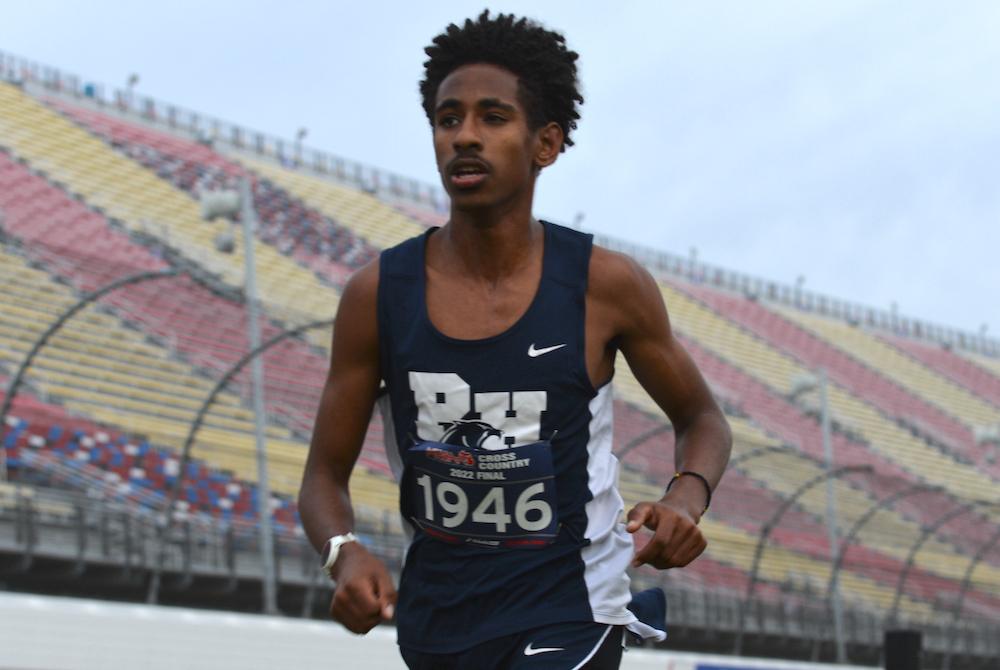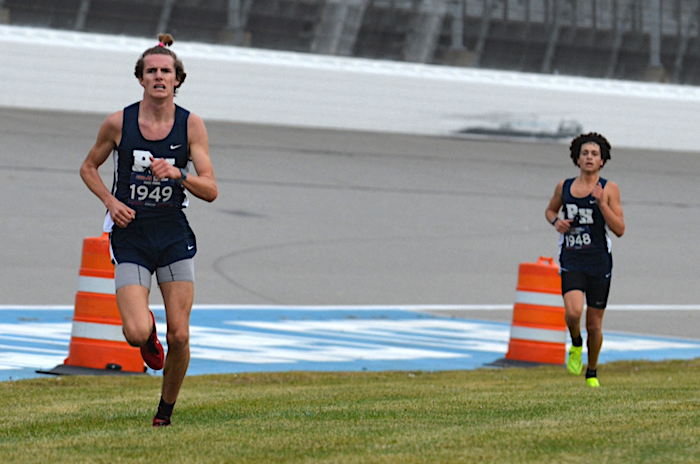
Potter's House Sweeps Top 3 Places, LPD4 Team & Individual Titles
November 5, 2022
BROOKLYN – This year, it wasn’t just about individual glory for Lezawe Osterink.
As soon as Osterink crossed the finish line after winning his second MHSAA Lower Peninsula Division 4 cross country championship Saturday, his thoughts turned to his Wyoming Potter’s House Christian teammates who were still on the course.
He didn’t have to wait long for his friends to join the postrace party.
Potter’s House became the first boys team to sweep the first three places in an MHSAA Final since the meet moved to Michigan International Speedway in 1996. The Pumas’ fourth and fifth runners weren’t too much farther back, giving Potter’s House a Division 4-record winning score of 35 points.
“Last year, we weren’t as good as this,” Osterink said. “It was more of an individual focus. This year, we can really win it and hopefully get that record. It was exciting. I love training with them.”
Osterink dominated the field, winning by 24.01 seconds in 15:36.84. Although he was running solo up front, he was aware of what was taking place behind him.
 “I could hear them,” he said. “Our coach got around to almost all the spots. He was updating me on how they were doing.
“I could hear them,” he said. “Our coach got around to almost all the spots. He was updating me on how they were doing.
“That’s just sweet. I don’t think any team in the state can do that right now. It’s cool to get 1-2-3 and the other guys following.”
The Pumas’ score is the third-lowest for a boys team at the MHSAA Lower Peninsula championships since 1956. The only lower scores both took place in 2006 when Pinckney won Division 1 with 27 points and Dexter won Division 2 with 28.
It was the first MHSAA cross country championship for the Pumas, who were 11th in 2020 and 12th last season. Potter’s House hadn’t qualified for the Finals before 2020.
Senior Logan Swiney was second in 16:00.85, and junior Jackson Rodriguez was third in 16:07.23 to complete the Pumas’ 1-2-3 sweep. Completing the team score were junior Ian Palacio, who was 11th overall and seventh in the team race in 16:42.91; and junior Noah Finton, who was 30th overall and 22nd in the team race in 17:18.00. All five scoring runners made all-state.
“It’s weird, because we’ve been thinking about it for so long,” Swiney said. “Ever since our first meet, we knew we could do it. It’s constantly putting in the work, and it worked out.”
Training with a Finals championship-caliber team brought out the best in all of the Pumas’ runners.
“In workouts, to have someone around your skill level, it does a lot,” Rodriguez said. “We push each other every day in practice. In races, you can push each other there, too.”
Johannesburg-Lewiston finished second with 101 points, while Petoskey St. Michael was third with 153.
PHOTOS (Top) Wyoming Potter’s House Christian’s Lezawe Osterink crosses the finish line first in the LPD4 Final on Saturday at MIS. (Middle) Teammates Logan Swiney (1949) and Jackson Rodriguez follow down the closing stretch as the Pumas swept the top three places. (Click for more from RunMichigan.com.)

MHSAA Vault: MIS Rose to Challenges to Host 2020 LP Finals
By
Rob Kaminski
MHSAA benchmarks editor
November 12, 2021
The “MHSAA Vault” features stories from past publications and other documents in the MHSAA Library. This issue takes a look at the MHSAA Cross Country Finals at Michigan International Speedway, which celebrated 25 years in 2020 – although it was an event that nearly didn’t happen last fall …
In 1996, the MHSAA and Michigan International Speedway began a partnership the changed the course of the Lower Peninsula Cross Country Finals – quite literally.
The land in and around the track at Brooklyn would host the Finals for all classes of runners in one place on one day, an annual festival of nearly 2,000 runners competing for the MHSAA’s top honors.
Even skeptics – and there were several among running purists who thought the course was too flat, for example – can’t deny the results.
Finals attendance nearly doubled in that first year, and crowds in excess of 10,000 have enjoyed a day of racing several times, including a record 12,153 in 2011.
Enthusiastic crowds were the norm in recent years, with 11,232 in 2017, and nearly 11,000 in 2018 (10,989) and 2019 (10,873).
In fact, attendance failed to reach at least 8,000 only twice since the move to MIS.
Of course, last year was an exception, when attendance was limited to 1,000 spectators per session due to the COVID-19 Pandemic. Fans also were restricted to the grandstands rather than following the action throughout locations on the course.
To reduce the number of runners in each race, the event was spread over two days, with each Division being run in two separate “sections” with times then combined at the end to determine team and individual champions.
While not ideal, the end result was another year of fantastic efforts at MIS – both from student-athletes and those behind the scenes.
“Even at the last hour, less than a week ahead of the Finals, we were closer to not having the Finals than we were to having them,” said MHSAA Assistant Director Cody Inglis, who coordinates the cross country postseason. “Rumors and challenges of mandated shutdowns, testing and other requirements were being discussed and caused a lot of unknowns. Even at the Regional level, we had schools, Regional courses and hosts shutting down their facilities; we had to relocate four Regionals 48 hours prior to race times. That scenario just could not happen at the Finals level where far more runners and much more travel would be involved.”
Among the many last-minute hurdles was the edict from NASCAR – which owns MIS – that all persons on site be temperature checked upon entry. That meant securing thermometers that were easy to operate in short order, along with personnel necessary to conduct the readings.
The attendance limitations certainly helped to implement the temperature screening, but brought their own issues.
“Limiting spectators was not a popular decision, but it really was the only way to have a race,” Inglis said. “We were taking direction and working with policies and protocols from the MDHHS, the Governor’s office, Lenawee County Health Department, MIS and NASCAR.”
Part of the solution was to utilize the grandstands as a “barrier” between participants and spectators. The reduced number of fans were dispersed over thousands of seats while still allowing them the chance to watch their student-athletes compete.
“It wasn’t the same, it wasn’t easy or perfect, but it was what we had to do to have a race,” Inglis said. “Separating the Finals into two days and different sections also allowed us to spread out the event and limit the number of people on site at any one time. This was a key part of the plan and worked well even though it separated races within a Division.”
The MHSAA, MIS and the cross country community never lost focus of the main goal: a culmination of the season for the student-athletes, who deserved something last year more than ever. And, more than ever, MIS once again displayed its advantage as a venue that could adapt to the fluid nature of the times to pull off the event.
“There were some thoughts of using four different sites, but as we learned during the Regionals, the climate of things was so tenuous from one area of the state to another that we couldn’t be 100-percent certain that there wouldn’t again be last-minute cancelations,” Inglis said. “MIS was wonderful to work and collaborate with, and was the best option to get it done. It was never mentioned once publicly about the possibility of not having the Finals – only how we could best do it under uncharted conditions.”
The moving parts and ever-changing scenarios created more complexity than ever in finalizing a season, but every decision was made with the complete desire to conduct the Finals as close to normal as possible.
“I firmly believe that a finish to the season, no matter the differences in race formatting and fan experience, was something everyone would have taken when the season began in August,” Inglis said.
Indeed, the finish line in Year 25 at MIS might have been the most gratifying of them all.

